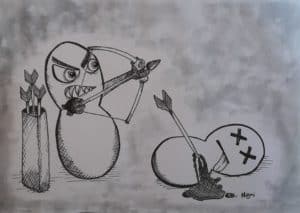The bacterial world is incredibly colourful, fascinating and most of all: diverse. Even within one bacterial family, the siblings can be different.
And looking at these bacterial siblings can help researchers understand the basic mechanisms of the bacterial world.
For example, some bacterial families contain both pathogenic and non-pathogenic bacteria. Pathogenic bacteria are those, that have weapons to infect us and make us sick.
On the contrary, non-pathogenic bacteria are harmless to us since they do not have these weapons.
But to fight off the dangerous bacteria, we still need to better understand what turns a harmless bacterium into a nasty one. Thus, researchers are trying to learn more about the differences between pathogenic and non-pathogenic bacteria.
So, what is better than looking at bacterial siblings that are both pathogenic and non-pathogenic. They often carry the same or similar genes. And yet, they have different weapons and some of these harm us while others don’t.
One interesting example of a bacterial family with diverse siblings is Vibrio cholerae.

Vibrio cholerae and its good and bad bacterial siblings
Bacteria from the Vibrio cholerae family live on zooplankton and shellfish in brackish waters. Every once in a while, we come into contact with such a bacterium when we eat seafood or drink contaminated water. And unfortunately, some siblings of the Vibrio cholerae family can cause very dangerous and even life-threatening diarrhoea. These are the pathogenic siblings.
But interestingly, not all bacterial siblings can infect our gastrointestinal tract. These non-pathogenic siblings do not have the right tools to infect and harm us.
Therefore, researchers have been curious about what distinguishes these pathogenic and non-pathogenic siblings.
All these siblings – pathogenic or non-pathogenic – have one killer machine in common. They use a bow to fire toxic arrows into prey cells. And these cells can be bacteria, amoebae or even human cells.

Yet, within the Vibrio cholera family, not every sibling has the same set of arrows and cannot fight the same target. Hence, researchers assumed that these different sets of arrows would give the siblings the skills to become a pathogen or not.
Vibrio cholerae siblings fight off amoebae with bow and arrow
Researchers looked at five siblings from the Vibrio cholerae family and their fighting behaviour. Let’s call these siblings Pan, Ariel, Bobby, Chris and Danny.
These five bacterial siblings all have the same bows. Yet, they have different arrows that give them different fighting powers.
So, the five siblings use these arrows to defend themselves against enemies in the environment, other bacteria or even their own siblings. Some of these enemies are even bigger microorganisms like amoebae.
These amoebae are like human immune cells. They hunt and eat bacteria in similar ways.
Hence, some Vibrio cholerae siblings use their bows and arrows to protect themselves from amoebae. For example, the siblings Chris and Danny have arrows that they fire into the amoebae. These arrows have toxic bullets attached to them so that they can kill the amoebae.
Ariel and Bobby have the same kind of arrows, but these do not carry the toxic bullets. Since Ariel and Bobby cannot kill amoebae, researchers suggested that only Chris and Danny use their toxic arrows to protect themselves from amoebae.

In comparison, Pan has the same arrow and the same toxic bullets. But Pan’s bow is not active. It only gets activated under certain circumstances. Hence, when Pan faces an amoeba, it gets eaten even though it has the weapon to defend itself. Poor Pan.
Vibrio cholerae siblings kill bacterial opponents with bow and arrow
Next, their different arrows also help our bacterial siblings when facing bacterial enemies. All siblings react and defend themselves in different ways.
Since Pan’s bow is inactive, it cannot fight off bacterial enemies. Even though it has many strong arrows. It just does not fire them.
The other siblings, however, know how to use their bows and arrows. And since their arrows deliver different toxic bullets, they kill with different efficiencies.
It becomes more interesting when these siblings fight each other. In these family fights, the toxic bullets make the difference.
For example, the four siblings Ariel, Bobby, Chris and Danny can all kill off Pan easily. This is because Pan does not have an active bow, so it would not fire any arrows. Pan does not stand a chance against its siblings.
Ariel has very toxic bullets. And it does not hesitate to fire them into its siblings to kill them.
Not Bobby. Bobby struggles with fighting off other bacteria as well as its siblings. Hence, researchers suggest that Bobby’s arrows and bullets are less toxic and thus less efficient to kill.
These types of experiments help researchers understand how bacterial siblings are immune to each other’s attacks. And it gives them some clues about what makes a toxic truly efficient.
Different powers give bacteria different advantages
Just as your special skills give you great opportunities or advantages in life, bacteria use their fighting powers to survive and thrive. They learned how to defend themselves against enemies of all kinds and families. And some of them seem to have more or less efficient ways to achieve this.
So, by learning about the defence mechanisms of bacteria, we might be able to find new and better ways to fight off the nasty bacteria ourselves. Let’s hope that one day we can fight them with their own weapons.









